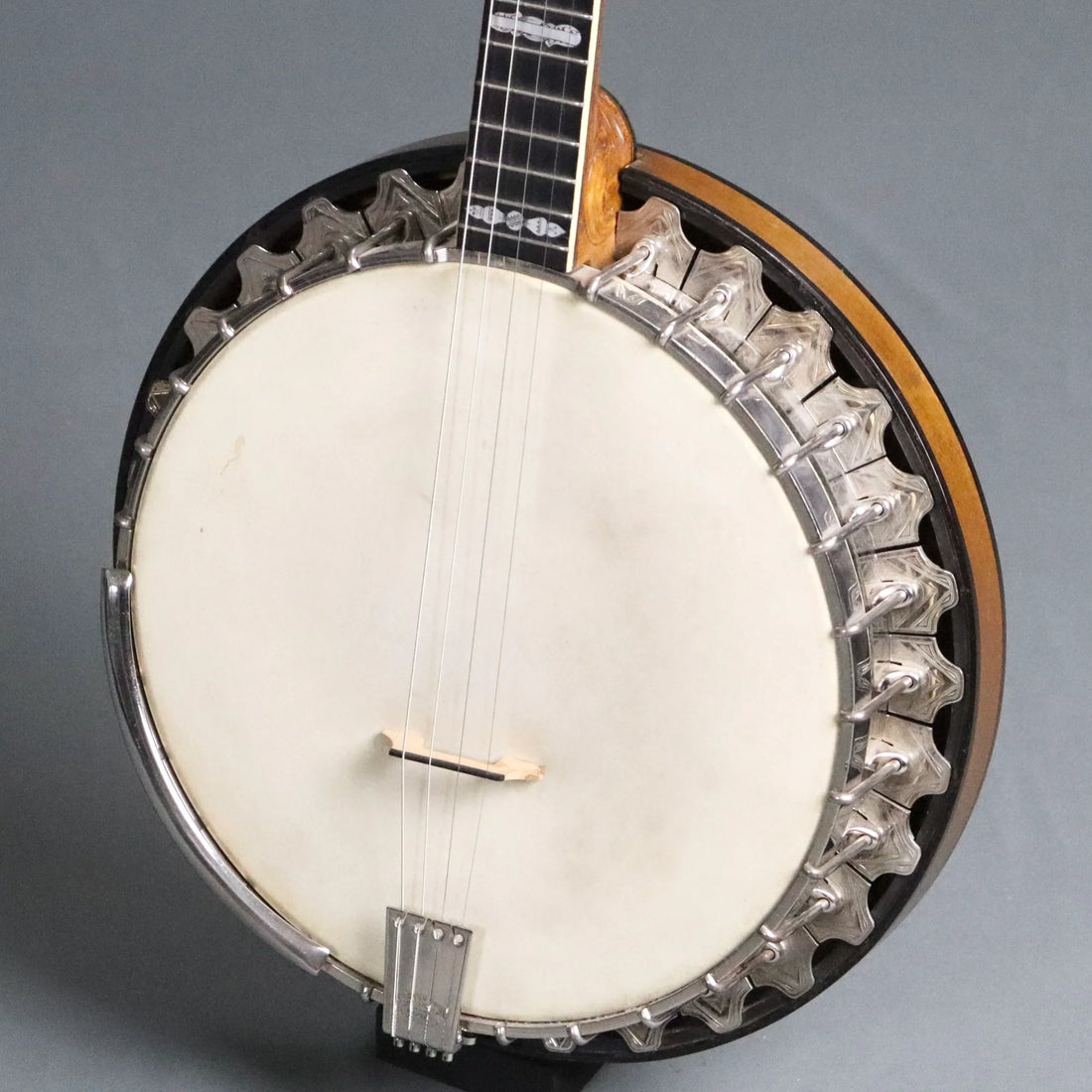Vintage banjos come in a wide variety of string configurations and construction styles. Each type of banjo has its own unique sound and is tuned differently, making them suitable for different playing styles and types of music. Whether you're a banjo enthusiast or a musician looking to explore new sounds, this guide will introduce you to the different types of vintage banjos and their various musical applications.
1. 5-String Banjo
The 5-string banjo was one of the first styles to be created, and is one of the more common type of banjo in modern times. Early on the gut string version of the 5 string banjo was commonly used in the "Classic Banjo" style of Fred Van Epps, Vess Ossman, and Fred J. Bacon. Now, string with steel strings, it's more widely used in bluegrass, folk, and country music. Modern five strings consist of four long strings and a shorter fifth string, known as the drone string. The drone string is typically tuned to a high open G note, while the other four strings are tuned to a standard open G tuning (D-G-B-D).
 A very rare 1890s SS Stewart 5-string Orchestra SSS Banjo with a 13” German Silver Rim
A very rare 1890s SS Stewart 5-string Orchestra SSS Banjo with a 13” German Silver Rim
2. Tenor Banjo
Most vintage 1920s era banjos are tenors due to the popularity of jazz and other traditional music forms. The tenor banjo is a four-stringed instrument that is often used an early jazz rhythm instrument, and in Irish and other traditional music styles. 19 fret (from the headstock to the body) tenors are usually used for jazz and tuned to C-G-D-A. Short scale 17 fret banjos are often reserved for Irish music and tuned G-D-A-E, an octave lower than the mandolin. The tenor banjo has a shorter neck and a brighter, crisper sound compared to the 5-string banjo.
3. Plectrum Banjo
The plectrum banjo is another four-stringed banjo that is commonly used in traditional jazz and Dixieland music, often as a solo instrument. It is usually played with a pick, hence its name. Most plectrum banjo players use the C-G-B-D tuning specific to the instrument. However some use "Chicago Tuning," or D-G-B-E like the top four strings of a guitar. A lot of guitarists who double on banjo prefer Chicago tuning for this reason. Its longer neck and longer scale give is a fuller tone. A fancy 1961 Vega / Martin VOX Ultra De-Luxe V Plectrum Banjo
A fancy 1961 Vega / Martin VOX Ultra De-Luxe V Plectrum Banjo
4. Banjo Guitar
The banjo guitar, also known as the banjitar or guitjo, is a hybrid instrument that combines the banjo's body with the guitar's neck and tuning. It has six strings and is tuned like a guitar (E-A-D-G-B-E). The banjo guitar offers a unique blend of the banjo's twangy sound with the familiarity of a guitar, making it versatile for various musical genres.
5. Banjo Ukulele
The banjo ukulele, also known as the banjolele, is a small, four-stringed instrument that combines the ukulele's body with the banjo's sound. It is typically tuned to G-C-E-A, the same tuning as a standard ukulele. The banjo ukulele produces a bright and lively sound, making it popular in folk and traditional Hawaiian music.
6. Banjo Mandolin
The banjo mandolin, also known as the banjolin or banjoline, is a hybrid instrument that combines the mandolin's neck with the banjo's body and sound. It typically has four pairs of strings, like a mandolin, and is tuned like a mandolin (G-D-A-E). The banjo mandolin offers a unique tone that is brighter and more percussive than a standard mandolin.
Resonator Vs. Open Back Style Banjos
Many banjos have a resonator attached to the back of the banjo's rim. This enhances the instrument's volume and projection by reflecting its sound outward. This design results in a brighter, more focused tone with pronounced highs and a punchy, clear midrange, making it suitable for genres like bluegrass where cutting through a mix is essential.
On the other hand, an open-back banjo lacks the resonator, resulting in a mellower, softer sound with less volume and sustain. The absence of the resonator allows the sound to disperse more freely, creating a warmer, rounder tone favored in folk, old-time, and clawhammer playing styles.
In terms of construction, the resonator banjo is typically heavier and bulkier due to the added component, whereas the open-back banjo is lighter and more streamlined, often with a simpler rim design.
In Conclusion
Each type of vintage banjo has its own distinct sound and is suited for different styles of music. Whether you're drawn to the twangy sound of a 5-string banjo or the bright tones of a banjo ukulele, exploring the world of vintage banjos can open up a whole new realm of musical possibilities. So, grab your favorite vintage banjo and start strumming or plucking to discover the unique sound that resonates with you!

